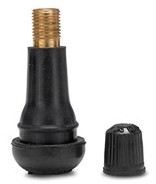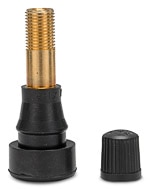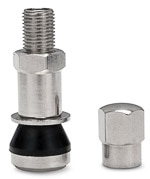


Tubeless rubber snap-in valves allow a maximum cold tire inflation pressure of 65 psi and are designed for passenger car, light-duty trailer and light truck applications, as well as are suitable for use in autocross competition. Rubber snap-in valves are available to fit either .453" or .625" diameter holes in the rim and have effective lengths ranging from 7/8" to 2-1/2". While most rubber snap-in valves use a plastic cap, some are fitted with chrome sleeves and metal caps to help complement the appearance of custom or alloy wheels.

|
TR Valve Number |
Max Inflation Pressure (PSI) |
Effective Length (Inch) |
Hole Diameter in Wheel (Inch) |
|---|---|---|---|
| 412 | 65 | 0.88 | 0.453 |
| 413 | 65 | 1.25 | 0.453 |
| 414 | 65 | 1.50 | 0.453 |
| 415 | 65 | 1.75 | 0.453 |
| 418 | 65 | 2.00 | 0.453 |
| 423 | 65 | 2.50 | 0.453 |
| 415 | 65 | 1.25 | 0.625 |
| 425 | 65 | 2.00 | 0.625 |
 Tubeless snap-in valves for high-pressure applications are designed for medium and heavy-duty trucks and trailers and must be used when recommended cold tire inflation pressures exceed 65 psi. High-pressure snap-in valves for .453" rim holes allow a maximum cold inflation pressure of 80 psi while those for .625" rim holes allow a maximum cold inflation pressure of 100 psi. Typically used in steel wheels, high-pressure snap-in valves combine a thicker rubber snap-in base with a metal barrel and a plastic cap. Effective lengths range from about 1-1/4" to 2
Tubeless snap-in valves for high-pressure applications are designed for medium and heavy-duty trucks and trailers and must be used when recommended cold tire inflation pressures exceed 65 psi. High-pressure snap-in valves for .453" rim holes allow a maximum cold inflation pressure of 80 psi while those for .625" rim holes allow a maximum cold inflation pressure of 100 psi. Typically used in steel wheels, high-pressure snap-in valves combine a thicker rubber snap-in base with a metal barrel and a plastic cap. Effective lengths range from about 1-1/4" to 2
|
TR Valve Number |
Max Inflation Pressure (PSI) |
Effective Length (Inch) |
Hole Diameter in Wheel (Inch) |
|---|---|---|---|
| 600HP | 80 | 1.27 | 0.453 |
| 602HP | 80 | 2.00 | 0.453 |
| 801HP | 100 | 1.31 | 0.625 |
| 802HP | 100 | 2.00 | 0.625 |
 High-pressure metal clamp-in valves can be used with virtually any wheel and are highly recommended for all track activities, as well as when vehicle speeds may exceed 130 mph. Metal clamp-in valves use a rubber grommet to seal against the wheel when their retaining nut is tightened. While metal clamp-in valve design and styling can result in retaining nuts hidden inside the wheel or visible outside, those with the retaining nut on the outside offer a practical benefit of allowing retaining nut tightness to be checked and adjusted without having to remove the tire from the wheel. Metal clamp-in valves allow a maximum operating pressure of 200 psi and are available to fit either .453" or .625" rim holes, as well as specialty applications, such as 6mm (.236") or 8mm (.315") holes. Metal clamp-in valves use a metal cap and have effective lengths ranging from flush to 2" and are offered in straight or bent configurations to fit wheels with unique shapes. Low profile and lightweight alloy clamp-in valves are also available for racing applications.
High-pressure metal clamp-in valves can be used with virtually any wheel and are highly recommended for all track activities, as well as when vehicle speeds may exceed 130 mph. Metal clamp-in valves use a rubber grommet to seal against the wheel when their retaining nut is tightened. While metal clamp-in valve design and styling can result in retaining nuts hidden inside the wheel or visible outside, those with the retaining nut on the outside offer a practical benefit of allowing retaining nut tightness to be checked and adjusted without having to remove the tire from the wheel. Metal clamp-in valves allow a maximum operating pressure of 200 psi and are available to fit either .453" or .625" rim holes, as well as specialty applications, such as 6mm (.236") or 8mm (.315") holes. Metal clamp-in valves use a metal cap and have effective lengths ranging from flush to 2" and are offered in straight or bent configurations to fit wheels with unique shapes. Low profile and lightweight alloy clamp-in valves are also available for racing applications.
Regardless of the valve type, the valve core is the fundamental sealing device and should be snugly screwed into the valve core chamber. Valve cores come in short and long lengths, with the short length being preferred for high performance applications.
Both nickel-plated and brass valve cores are available. The nickel-plated valve cores must be used in the aluminum valve stems of tire pressure monitoring sensors because using a standard brass valve core in an aluminum tire pressure sensor valve stem will experience galvanic corrosion and the brass valve core will eventually seize in the valve's aluminum barrel.
All valve cores feature a seal attached to a movable, spring-loaded pin that allows pressurized air to pass when inflating a tire, as well as air to escape when the pin is depressed to unseat the seal. While valve cores themselves can accept a working pressure of 300 psi, it is important to protect them from grit, sand and moisture. Grit and sand might prevent valve cores from sealing completely, and moisture can freeze in cold temperatures and defeat the seal.
High-speed pressure loss and core contamination are several of the reasons why valve caps should always be used. In case anything disrupts the valve core's seal, the valve cap provides a backup seal that prevents air from escaping. And while using valve caps will make it take longer to check tire pressures in the pits at a racetrack, the consequence of having a tire lose pressure is much worse.
Three types of valve caps are available: plastic dome, metal dome or a metal "screwdriver" design used to tighten and loosen valve cores. The plastic dome caps are fine for normal driving and autocrossing, however they should be replaced with metal valve caps to withstand the high temperatures experienced during racetrack driving. Valve caps are knurled to make it easier to tighten or loosen them, while some metal caps feature hex head designs. Metal caps use a rubber washer or o-ring to seal the valve completely.
If the valve cap is missing, it is best to press the valve core momentarily to release a little air before checking or adding air pressure. This will allow the compressed air inside the tire to blow debris out of the valve. Avoiding moisture is more difficult to address, because it is often hard to find a consistent source of dry air. Checking or adding air tire inflation pressure outside in the middle of a snowstorm is not recommended unless absolutely necessary.
Vehicles that use wheel covers may also use nylon or metal extensions that range from 1/2" to 2" in length to make it easier to check and adjust tire pressures. Because the tips of the nylon extensions are open to the elements, mud, ice and snow have been known to pack into them and allow air to escape. Additionally, if the nylon extensions are scraped against a curb, the damaged tip can depress the valve core and allow air to escape. Ideally, appropriate length tire valves, or metal extensions that are threaded to accept a valve cap should be used.
NOTE: Metal extensions can also be helpful when inflating wheels fitted with short or difficult to reach tire valves.
Since rubber deteriorates over time and tire valves are not expected to resist deterioration for the life of two standard tires in normal service, tire valves should be inspected and replaced if any cracking appears. As a rule of thumb, the industry recommends replacing tire valves whenever new tires are installed.
While Track & Competition DOT tires may only last several weekends on your track driven racecar, the metal clamp-in tire valves should be replaced every other year because the heat transmitted to the wheels from the brakes is significantly greater than that experienced in normal service.
Special metal clamp-in or rubber snap-in valves are also used to anchor the sensor/transmitters used by the many direct tire pressure monitoring systems (TPMS). These unique metal clamp-in valves feature a threaded insert in their base to accept the bolt that attaches the sensor/transmitter to the valve.
For all details, You can find from our website.